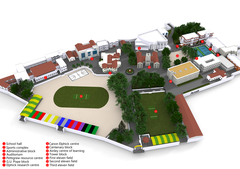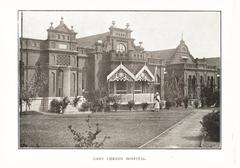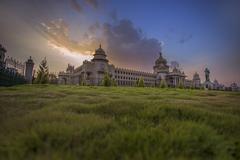Visiting St. Mary’s Basilica: Hours, Tickets, and Historical Sites in Bangalore
Date: 16/08/2024
Introduction
St. Mary’s Basilica in Bangalore, also known as Bengaluru, is more than just a place of worship; it is a historical and cultural landmark that has witnessed centuries of transformation, resilience, and communal harmony. Established as early as the 17th century, the basilica’s journey from a modest chapel to its current status as a Minor Basilica reflects the dynamic history of the region and its people (Deccan Herald). Nestled in the bustling area of Shivajinagar, the basilica stands as a testament to Gothic Revival architecture, featuring towering spires, ribbed vaults, and intricate stained glass windows that narrate biblical stories (imvoyager.com). The basilica holds a special place in the hearts of Bangaloreans, transcending religious boundaries and serving as a beacon of hope, especially during critical moments like the plague of 1898 and the COVID-19 pandemic (TravelSetu). Whether you are a history buff, an architecture enthusiast, or a spiritual seeker, St. Mary’s Basilica offers a unique and enriching experience that captures the essence of Bangalore’s rich cultural tapestry.
Table of Contents
- Introduction
- History of St. Mary’s Basilica
- Architecture of St. Mary’s Basilica, Bangalore
- Visitor Information
- Renovations and Restorations
- Conclusion
- FAQ
Ultimate Guide to Visiting St. Mary’s Basilica in Bangalore
History of St. Mary’s Basilica
Early Beginnings and Establishment
St. Mary’s Basilica in Bangalore, originally known as the Church of Our Lady of Presentation, has a rich history that dates back to the 17th century. The initial establishment of Christianity in the region can be traced to 1648 when it first entered Srirangapatna, the then capital of Mysore province. Bangalore, still a small city at the time, saw its first church, Drummers Chapel, built during the tenure of Hyder Ali in 1724-25 (Deccan Herald).
The Plague and Transformation
In 1898, Bangalore was struck by a deadly plague that claimed thousands of lives. The epidemic spread through Blackpalli (now Shivajinagar), prompting people of all faiths—Hindus, Muslims, and Christians—to gather inside a small Catholic church and pray at the shrine of Mother Mary for deliverance and healing. Miraculously, many were cured, leading to the church being named ‘Annai Arokiamarie’ (Our Lady of Good Health). This event marked a significant transformation in the church’s history, as it became a place of worship for people of all faiths (Deccan Herald).
Architectural Evolution
The church underwent several architectural changes over the years. Initially, a small chapel with a thatched roof was built facing the east and named Kanikaimatha Devalaya (Church of Our Lady of Presentation). Over time, new features such as a dome and extensions to the nave and wings were added. The present form of the church was constructed in June 1875 and was solemnly consecrated on September 8, 1882, in the presence of 35 priests and 4,000 Catholics of Bangalore (Deccan Herald).
Communal Riots and Reconstruction
In 1832, the church faced a significant setback due to communal riots. The church was pulled down and pillaged, with the parish priest narrowly escaping death. Troops had to be brought in to restore peace and guard the church for months. Despite these challenges, the church was rebuilt and continued to serve as a significant place of worship. The British authorities in Delhi recognized its historical importance and paid a grant every year for its maintenance until 1948 (Deccan Herald).
Gothic Architecture and Design
St. Mary’s Basilica is an architectural marvel built in the Gothic style. The church is designed in the form of a Cross, featuring stately arches, ornamental motifs, and stained-glass windows. The imposing and magnificent tower forming the façade of the church stands at 160 feet high, making it a prominent landmark in Bangalore. The church’s design and structure have made it a significant attraction for both devotees and tourists alike (Deccan Herald).
Recognition and Status
Recognizing the deep devotion of people of all faiths to Our Lady of Good Health, the church was elevated to the status of ‘Minor Basilica’ in 1973 by Pope Paul VI. This recognition further solidified its importance as a major shrine of worship and a symbol of communal harmony in Bangalore. The basilica continues to attract devotees from all over the country, making it a significant religious and cultural landmark (Deccan Herald).
Modern-Day Significance
During the Covid-19 pandemic, the church remained locked, but the shrine of Mother Mary outside the church was kept open. Many people passing by would stand at the gate, look into the shrine, and pray. Some would come in, light a candle, kneel, and pray, demonstrating the enduring significance of the basilica in the lives of the people. The basilica’s history and its role in the community continue to be a testament to its importance in Bangalore’s cultural and religious landscape (Deccan Herald).
Historical Context and Community Impact
The basilica’s history is intertwined with the broader history of Bangalore and the Mysore State. Following the death of Tipu Sultan in 1799, the British seized Srirangapatna, leading to the rejuvenation of Christianity in the region. The basilica stands as a symbol of this rejuvenation and the resilience of the Christian community in Bangalore. Its historical significance and architectural beauty make it a must-visit destination for anyone interested in the rich cultural heritage of Bangalore (Deccan Herald).
Architecture of St. Mary’s Basilica, Bangalore
Gothic Revival Design
St. Mary’s Basilica in Bangalore is a prime example of Gothic Revival architecture, a style that emerged in the late 18th century and gained popularity in the 19th century. The basilica’s design was commissioned by Father Jean-Antoine Dubois, a French missionary, and executed by a French architect in 1874 (imvoyager.com). The church’s Gothic elements are evident in its towering spires, ribbed vaults, and pointed arches, which create an imposing and majestic structure.
Structural Dimensions
The basilica stands 160 feet tall, with a length of 172 feet and a breadth of 50 feet (catholicshrinebasilica.com). The height of the tower forming the facade is also 160 feet, making it a prominent landmark in the Shivajinagar area of Bangalore. The church is designed in the shape of a cross, a common feature in Gothic church architecture, which adds to its spiritual and aesthetic appeal.
Stained Glass Windows
One of the most striking features of St. Mary’s Basilica is its stained glass windows. These windows are not only decorative but also serve a functional purpose by allowing natural light to filter into the church, creating a serene and contemplative atmosphere. The stained glass depicts various biblical scenes and saints, adding to the spiritual ambiance of the basilica (imvoyager.com).
Ornamental Motifs and Arches
The basilica is adorned with intricate ornamental motifs and beautiful arches that enhance its Gothic character. These elements are meticulously crafted, showcasing the skill and artistry of the builders. The arches, in particular, are a defining feature of Gothic architecture, providing both structural support and aesthetic beauty (catholicshrinebasilica.com).
Statues and Sculptures
At the main entrance of the basilica, visitors are greeted by a statue of Mother Mary holding the Child Jesus, which stands 6 feet tall. This statue is draped daily in a sari, the traditional attire of Indian women, symbolizing the integration of local culture with Christian traditions (catholicshrinebasilica.com). Another notable statue is the smaller “Miraculous Statue of Our Lady,” which survived an attack in 1832 when the church was destroyed by miscreants. According to local legend, those who attempted to pull down the statue were struck blind (catholicshrinebasilica.com).
Interior Layout
The interior of St. Mary’s Basilica is designed to accommodate a large number of worshippers. The church features a spacious nave flanked by aisles, with a high altar at the eastern end. The ribbed vaults and pointed arches create a sense of verticality, drawing the eyes upward and enhancing the spiritual experience. The use of dark wood for the pews and other furnishings adds to the solemn and reverent atmosphere of the basilica (imvoyager.com).
Architectural Significance
St. Mary’s Basilica holds the distinction of being the first church in Karnataka to be elevated to the status of a minor basilica. This honor was bestowed by Pope Paul VI in 1973, recognizing the church’s architectural grandeur and its significance to the Catholic community in Bangalore (imvoyager.com). The basilica is not only a place of worship but also a cultural and historical landmark, attracting visitors from all over the world.
Visitor Information
Visiting Hours and Tickets
St. Mary’s Basilica is open to visitors daily from 6:00 AM to 8:00 PM. There is no entry fee, making it accessible to everyone. However, donations are welcome and go towards the maintenance of the basilica.
Accessibility and Travel Tips
St. Mary’s Basilica is strategically located in the Bengaluru Cantonment area, making it easily accessible by public transport or taxi. The nearest railway station is Krantivira Sangolli Rayanna (Bengaluru) Train Station, located 5.7 kilometers away, while the Kempegowda International Airport is 34.3 kilometers from the basilica (catholicshrinebasilica.com). For those driving, ample parking is available near the church.
Nearby Attractions
While visiting the basilica, you can also explore nearby attractions such as Cubbon Park, Bangalore Palace, and the bustling Commercial Street for shopping and dining experiences.
Cultural Integration
One of the unique aspects of St. Mary’s Basilica is its integration of local culture with Christian traditions. The daily draping of the Mother Mary statue in a sari is a testament to this cultural synthesis. The basilica also hosts masses in multiple languages, including English, Kannada, Tamil, and Malayalam, catering to the diverse Catholic community in Bangalore (traveltriangle.com).
Annual Feast and Celebrations
The annual feast of St. Mary, celebrated in September, is a major event that draws thousands of devotees from across Bangalore. The festivities include colorful processions, hymns, and special prayers, creating a joyous atmosphere that transcends religious boundaries. The highlight of the feast is the procession of the statue of Mother Mary, carried around the local streets in a beautifully adorned chariot (imvoyager.com).
Renovations and Restorations
Over the years, St. Mary’s Basilica has undergone several renovations and restorations to preserve its architectural integrity and accommodate the growing number of devotees. The most significant renovation took place between 2004 and 2007, during which the church was completely renovated and rededicated on August 29, 2006 (catholicshrinebasilica.com). This renovation marked the 125th anniversary of the basilica’s consecration.
FAQ
Q: What are the visiting hours for St. Mary’s Basilica?
A: The basilica is open daily from 6:00 AM to 8:00 PM.
Q: Is there an entry fee to visit St. Mary’s Basilica?
A: No, there is no entry fee, but donations are welcome.
Q: How can I reach St. Mary’s Basilica?
A: The basilica is located in the Bengaluru Cantonment area, easily accessible by public transport or taxi. The nearest railway station is 5.7 kilometers away, and the nearest airport is 34.3 kilometers away.
Q: Are there guided tours available?
A: Guided tours are not officially provided, but you can explore the basilica at your own pace.
Q: What languages are the masses conducted in?
A: Masses are conducted in multiple languages, including English, Kannada, Tamil, and Malayalam.
Conclusion
St. Mary’s Basilica in Bangalore is a magnificent example of Gothic Revival architecture, blending spiritual significance with cultural heritage. Its towering spires, stained glass windows, and intricate details make it a must-visit destination for anyone interested in architecture, history, or spirituality. Whether you are a devout Christian or simply an admirer of architectural beauty, a visit to St. Mary’s Basilica promises an enriching and memorable experience.
References
- Deccan Herald. (n.d.). Bengaluru’s Iconic St. Mary’s Basilicas and its Connection to the Plague. Deccan Herald
- imvoyager.com. (n.d.). St. Mary’s Basilica Bangalore. imvoyager.com
- TravelSetu. (n.d.). Best Time to Visit Mary’s Basilica Bangalore. TravelSetu
- catholicshrinebasilica.com. (n.d.). St. Mary’s Basilica Bangalore Karnataka. catholicshrinebasilica.com

